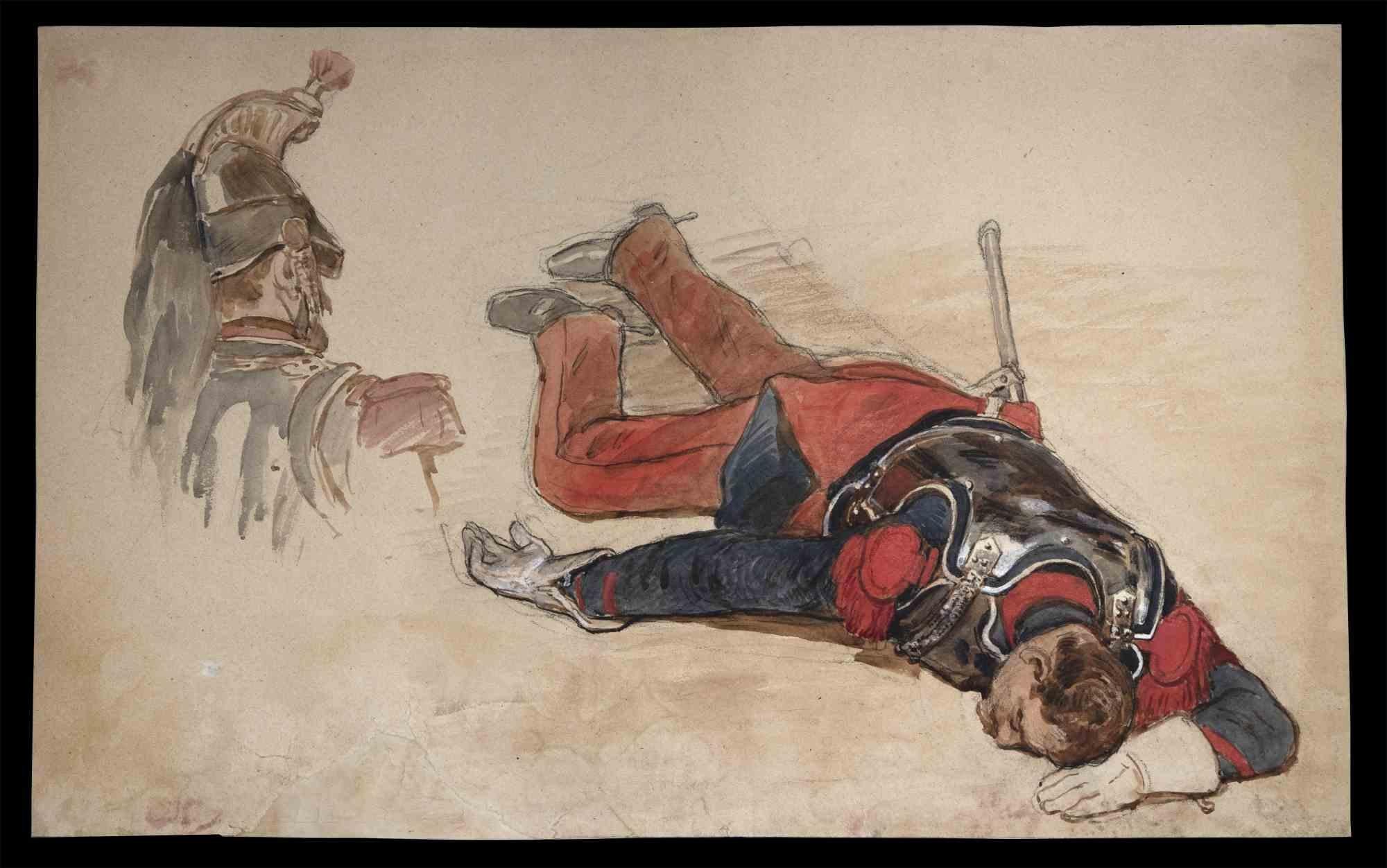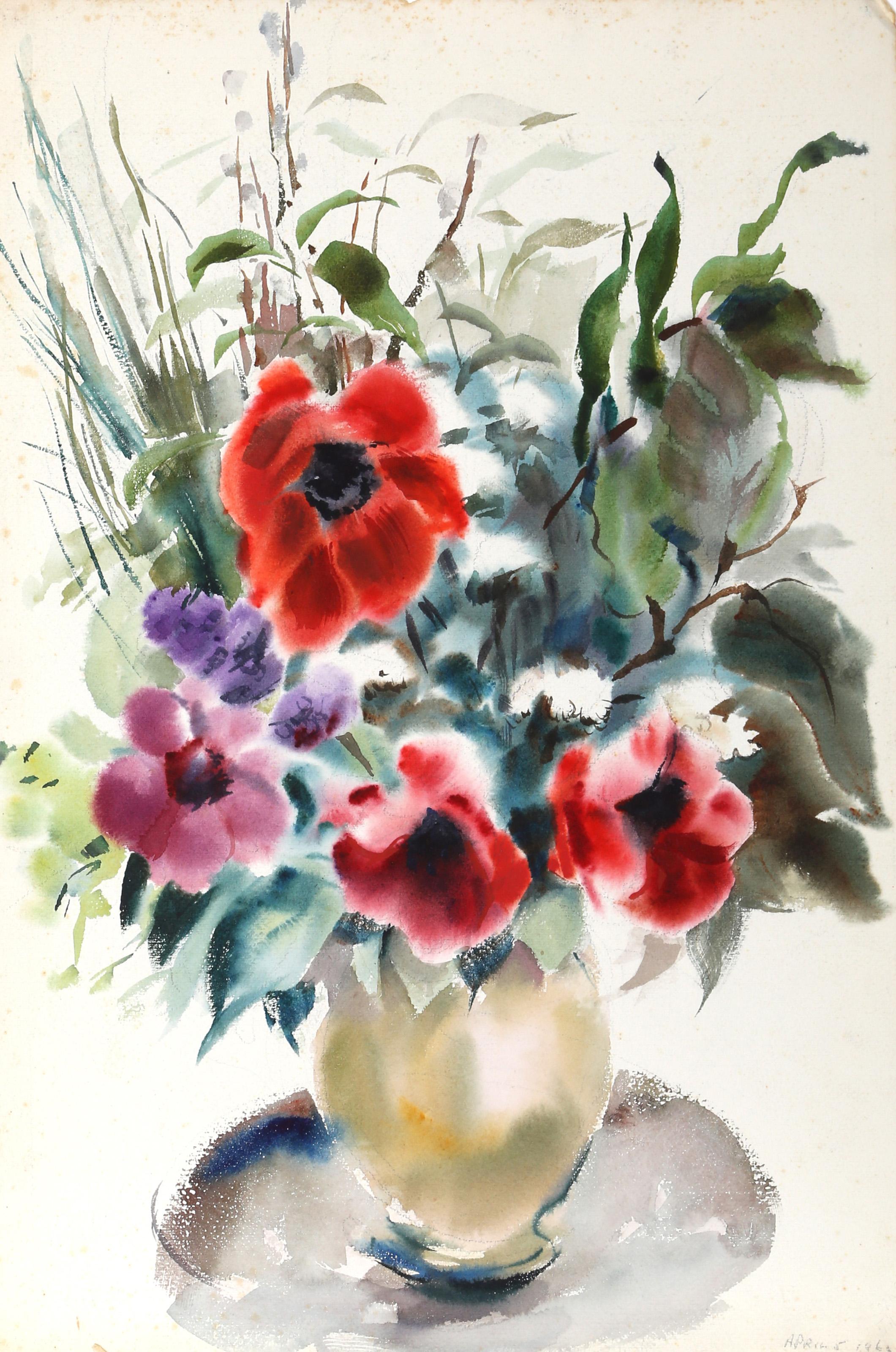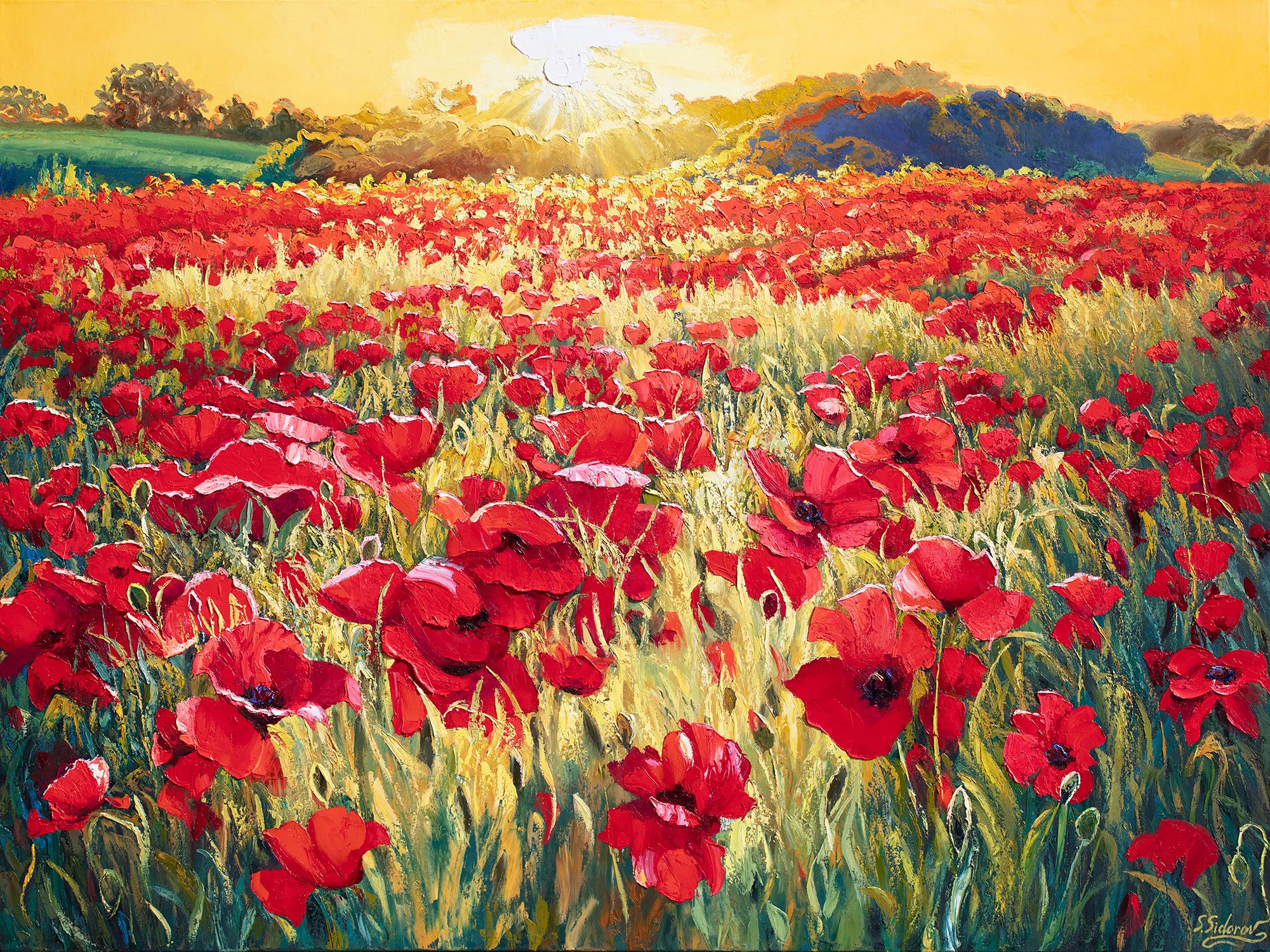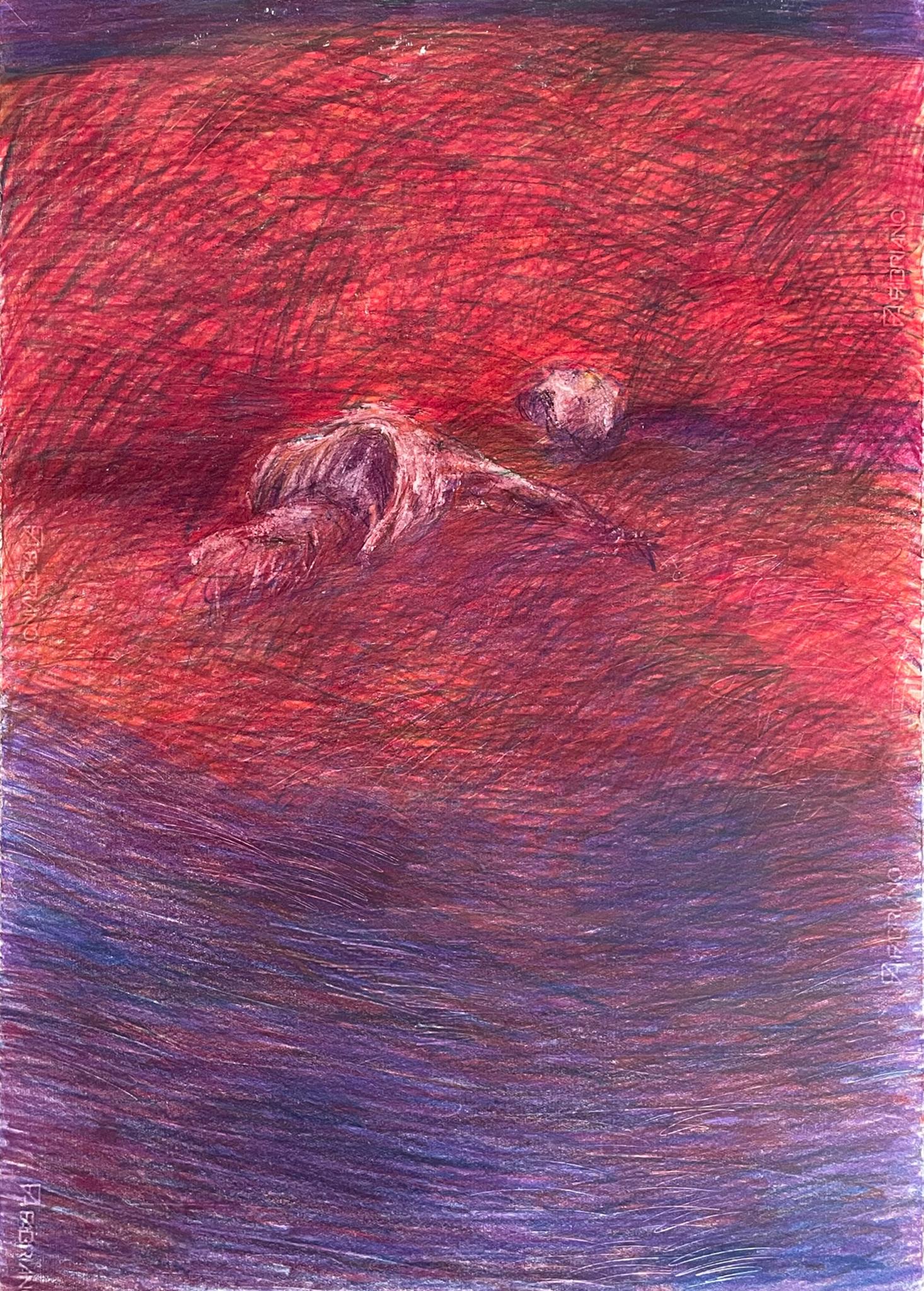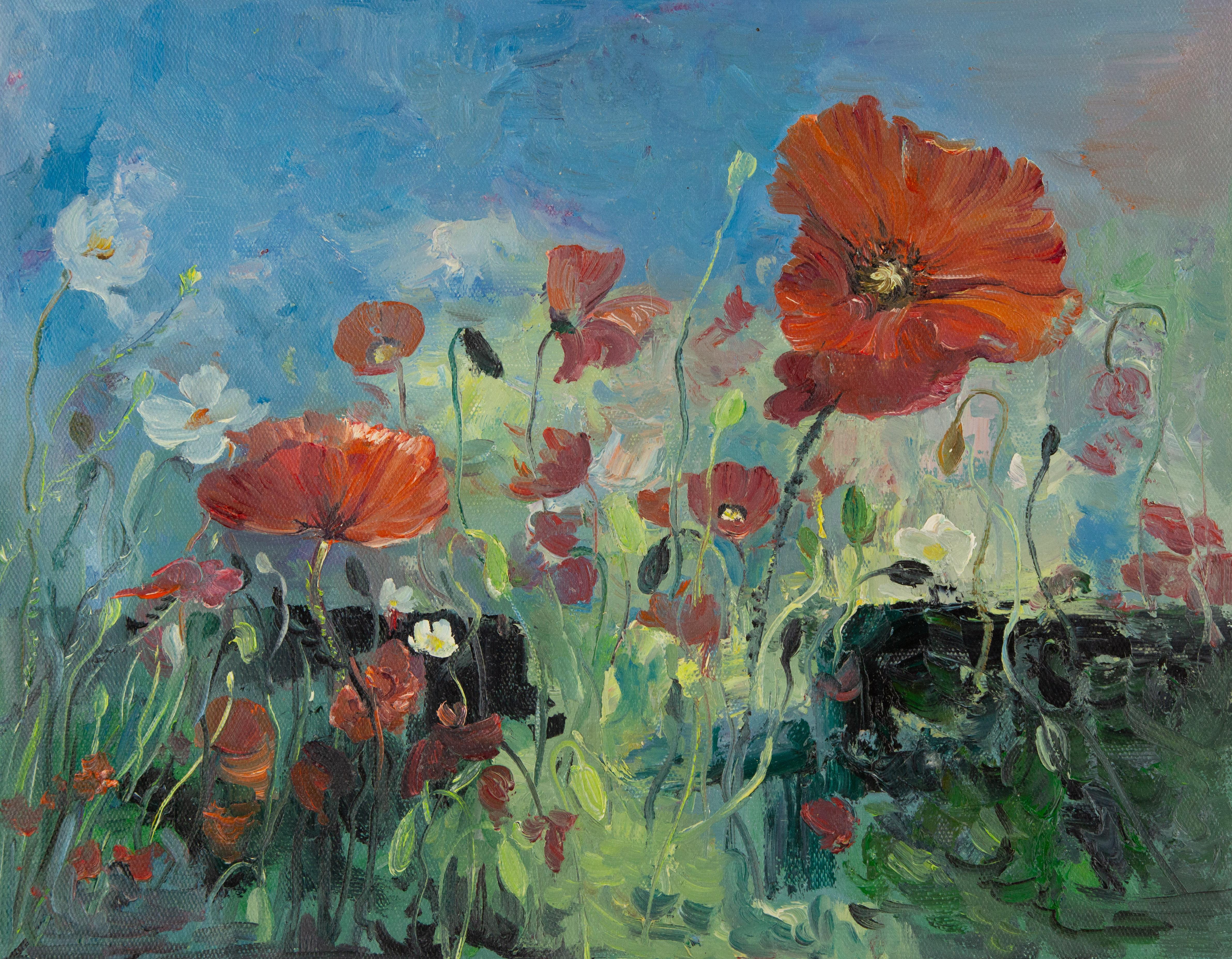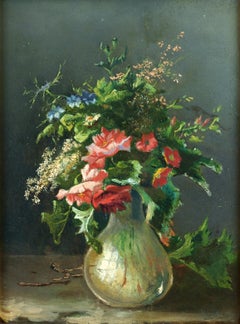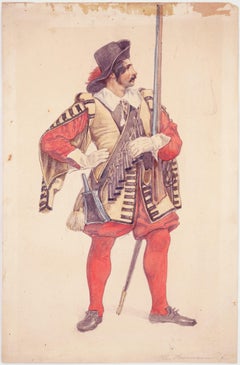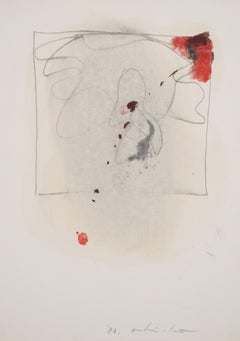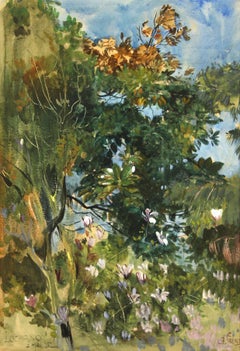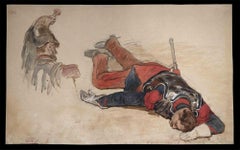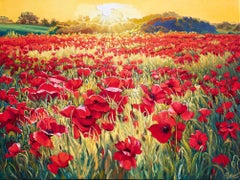Items Similar to Red blooming war landscape with dead soldier - Bleeding flowers -
Want more images or videos?
Request additional images or videos from the seller
1 of 8
Johannes HaenschRed blooming war landscape with dead soldier - Bleeding flowers -1918
1918
$1,343.08
$1,678.8520% Off
£999.12
£1,248.9020% Off
€1,120
€1,40020% Off
CA$1,839.14
CA$2,298.9220% Off
A$2,044.87
A$2,556.0920% Off
CHF 1,067.72
CHF 1,334.6520% Off
MX$24,891.04
MX$31,113.8020% Off
NOK 13,623.62
NOK 17,029.5220% Off
SEK 12,764.68
SEK 15,955.8520% Off
DKK 8,525.94
DKK 10,657.4320% Off
Shipping
Retrieving quote...The 1stDibs Promise:
Authenticity Guarantee,
Money-Back Guarantee,
24-Hour Cancellation
About the Item
Johannes Friedrich Heinrich Hänsch (1875-1945), Red blooming war landscape with dead soldier, 1918. Watercolor and gouache on paper, 15 x 24.5 cm (image), 27 x 37 cm (sheet size / frame), monogrammed and dated "19JH18" at lower left.
- Paper slightly darkened
About the artwork
Despite the relatively small format, the watercolor with an internal frame depicts a panoramic view of a flat landscape stretching to the horizon. As far as the eye can see, the poppies bloom in flaming red. The flowers are not rendered individually, however, creating an almost cohesive red surface. The bright red is interspersed with vegetal green. A complementary contrast that creates an intense color effect. In this color contrast, a white area breaks through from the middle ground, widening towards the foreground and surrounding a brown hole. Next to it, in blue, is the actual protagonist of the painting, the first thing that catches the eye: a dead soldier. Next to him is his helmet, revealing the empty interior. The brown, hollow shape corresponds to the hole in the ground. A shell funnel is surrounded by bright ash, which, like the inverted helmet, becomes a sign of death. The soldier's arms point to the funnel, while the empty helmet paraphrases the calotte of the skull and, like the funnel, thematizes the empty darkness of death.
The soldier's body, however, is intact and not - as in Otto Dix's triptych "The War" - a dismembered corpse. Instead, Johannes Hänsch activates the landscape, especially the color, to illustrate a blooming landscape of death that extends from the shell funnel in the foreground to the rising column of smoke on the horizon. If the soldier's body is intact, the tangle of barbed wire emblematically placed over the empty helmet also appears tattered. On the right side of the picture, the barbed wire even seems to stretch its arms to the sky in horror. Against the background of this allegory, the content of the bright red also becomes clear: the landscape is drenched in blood, literally a sea of blood, and the single unknown soldier stands pars pro toto for all those who died on the battlefield. Dying in war is not dying in community, but in solitude. In order to emphasize the isolation in death, Johannes Hänsch has set the blue of the soldier in the axis given by his body in the middle ground of the picture into the red sea.
A master of landscape painting, Hänsch succeeds in creating a natural-looking landscape allegory that illustrates the horror and death of war, without depicting the brutality of war itself. This singular 'war memorial' of the unknown soldier is the opposite of heroization and yet the dignity of the deceased soldier is preserved through the integrity of his body.
About the artist
As the son of the sculptor Adolf Haensch, the young Johannes received his first artistic training in his father's Berlin studio. However, he eventually decided to become a painter, and in 1897 he entered the Berlin Academy of Arts. He initially studied under Paul Vorgang and Eugen Bracht, and was particularly influenced by Bracht's increasingly colourful landscape painting. In 1901 he moved to the class of Friedrich Kallmorgen, with whom he spent several weeks on excursions into nature. In 1905 he became a master pupil of Albert Hertel, who taught him watercolour painting.
From 1903 to 1933 he exhibited annually at the Great Berlin Art Exhibition, the exhibitions of the Berlin Artists' Association and the Munich Glaspalast. In 1905 he was awarded the Carl Blechen Prize. From 1917 until his death in 1945 he spent every year in Silesia, where he rented a studio in Seitendorf an der Katzbach. He also travelled almost every year to paint in the Ore Mountains, to Merano and to the North and Baltic Sea. But he also remained faithful to the Brandenburg landscape, which he - along with Walter Leistikow - painted in a completely new way, earning him the nickname "painter of the Märkische landscape".
Selected Bibliography
Barbara Maennig: Landschaften des Berliner Meisterschülers Johannes Hänsch (1875-1945). Ein Weg zur deutschen Landschaftsmalerei im Spannungsfeld akademischer Lehre und künstlerischer Ansätze der Moderne, Berlin 2003.
Jelena Jamaikina (Hrsg.): Wanderungen durch die Mark. Der Maler Johannes Hänsch 1875-1945, Schwielowsee 2015.
Alexander Römer (Hrsg.): Zwischen Meeresbrandung und Wolkentreiben. Johannes Hänsch auf Sylt. Dresden 2017.
Richard Beetz: Johannes Hänsch in Schlesien - Der Berliner Landschaftsmaler und seine zweite Heimat, Schwielowsee 2021.
Thank you for your interest! I hope I have been able to explain to you the special character of the artwork. If you have any questions of any kind, please feel free to contact me.
I wish you many more discoveries in the realm of art,
Dr Martin Kirves
GERMAN VERSION
Johannes Friedrich Heinrich Hänsch (1875-1945), Rot blühende Kriegslandschaft mit totem Soldaten, 1918. Aquarell und Gouache auf Papier, 15 x 24,5 cm (Darstellung), 27 x 37 cm (Blattgröße / Rahmen), links unten monogrammiert und datiert „19JH18“.
- Papier leicht nachgedunkelt
zum Werk
Trotz des relativ kleinen Formats veranschaulicht das mit einem Binnenrahmen versehene Aquarell panoramaartig eine bis zum Horizont reichende flache Landschaft. So weit das Auge reicht blüht der Mohn in flammendem Rot. Dabei sind die Blüten allerdings nicht einzeln herausgearbeitet, wodurch eine nahezu zusammenhänge rote Fläche entsteht. Das leuchtende Rot wird vom vegetabilen Grün durchsetzt. Ein Komplementärkontrast, der eine intensive Farbwirkung erzeugt. In diesen Farbkontrast hinein bricht sich vom Mittelgrund her ein weißes Areal Bahn, das zum Bildvordergrund hin breiter wird und ein braunes Loch umgibt. In Blau gehalten liegt daneben der eigentliche Protagonist des Bildes, der bei der Betrachtung als erstes ins Auge fällt: Ein toter Soldat. Neben ihm ist sein Helm zu sehen, der das leere Innere offenbart. Die braune Hohlform korrespondiert mit dem Loch im Boden. Ein von heller Asche umgebener Granattrichter, der – wie der umgekehrte Helm – zum Zeichen des Todes wird. Die Arme des Soldaten weisen auf den Trichter, während der leere Helm die Schädelkalotte paraphrasiert und, wie der Trichter, das leere Dunkel des Todes thematisiert.
Der Körper des Soldaten ist allerdings unversehrt und nicht – wie bei Otto Dix' Triptychon „Der Krieg“ – ein zerstückelter Kadaver. Stattdessen aktiviert Johannes Hänsch die Landschaft und dabei insbesondere die Farbigkeit, um eine blühende Todeslandschaft zu veranschaulichen, die vom Granatrichter vorne bis zur aufsteigenden Rauchsäule am Horizont reicht. Ist der Körper des Soldaten unversehrt, so wirkt der emblematisch auch über den leeren Helm gesetzte Stacheldrahtverhau wie zerfetzt. Rechts im Bild scheint der Stacheldraht gar vor Entsetzen ‚die Arme‘ zum Himmel auszustrecken. Vor dem Hintergrund dieser Allegorie wird auch der Gehalt des leuchtenden Rots deutlich: Die Landschaft ist blutdurchtränkt, förmlich ein Meer aus Blut und der einzelne unbekannte Soldat steht pars pro toto für alle auf dem Schlachtfeld Gefallenen. Das Sterben im Krieg ist kein Sterben in Gemeinschaft, sondern in Einsamkeit. Um die Vereinzelung im Tod hervorzugeben, hat Johannes Hänsch das Blau des Soldaten in der von seinem Körper vorgegebenen Achse im Bildmittelgrund in das rote Meer hineingesetzt.
Als Meister der Landschafsmalerei gelingt es Hänsch eine ganz natürlich wirkende Landschaftsallegorie zu kreieren, die den Schrecken und das Sterben des Krieges veranschaulicht, ganz ohne die Brutalität des Krieges selbst darzustellen. Dieses singuläre ‚Kriegerdenkmal‘ des unbekannten Soldaten ist das Gegenteil einer Heroisierung und dennoch bleibt die Würde des verstorbenen Soldaten durch die Unversehrtheit seines Körpers gewahrt.
zum Künstler
Als Sohn des Bildhauers Adolf Hänsch erhält der junge Johannes seine erste künstlerische Ausbildung im Berliner Atelier seines Vaters. Er entscheidet sich schließlich jedoch Maler zu werden und nimmt 1897 das Studium an der Berliner Akademie der Künste auf. Zunächst studiert er bei Paul Vorgang und Eugen Bracht, wobei er besonders von der zusehends an der Farbe orientierten Landschaftsmalerei Eugen Brachts profitiert. Anschließt wechselt er 1901 in die Klasse Friedrich Kallmorgens, mit der er mehrwöchige Exkursionen in die Natur unternimmt. 1905 wird er schließlich Meisterschüler Albert Hertels, bei dem er die Kunst des Aquarellierens erlernt.
Bereits ab 1903 beschickt er bis 1933 jährlich die Große Berliner Kunstausstellung, die Ausstellungen des Vereins Berliner Künstler und den Münchner Glaspalast. 1905 wird er mit dem Carl-Blechen-Preis geehrt. Von 1917 bis zu seinem Todesjahr 1945 hält er sich in jährlich in Schlesien auf, wo er in Seitendorf an der Katzbach ein Atelier angemietet hat. Ebenfalls nahezu jährlich reist er zum Malen ins Erzgebirge, nach Meran und an die Nord- und Ostsee. Er bleibt aber auch der Brandenburger Landschaft treu, die er – parallel mit Walter Leistikow – künstlerisch ganz neu ins Bild setzt, was ihm den Beinamen „Maler der märkischen Landschaft“ eingetragen hat.
Auswahlbibliographie
Barbara Maennig: Landschaften des Berliner Meisterschülers Johannes Hänsch (1875-1945). Ein Weg zur deutschen Landschaftsmalerei im Spannungsfeld akademischer Lehre und künstlerischer Ansätze der Moderne, Berlin 2003.
Jelena Jamaikina (Hrsg.): Wanderungen durch die Mark. Der Maler Johannes Hänsch 1875-1945, Schwielowsee 2015.
Alexander Römer (Hrsg.): Zwischen Meeresbrandung und Wolkentreiben. Johannes Hänsch auf Sylt. Dresden 2017.
Richard Beetz: Johannes Hänsch in Schlesien - Der Berliner Landschaftsmaler und seine zweite Heimat, Schwielowsee 2021.
Vielen Dank für Ihr Interesse! Ich hoffe, ich habe Ihnen den besonderen Charakter des Kunstwerks näherbringen können. Bei Fragen jeglicher Art können Sie mich gerne kontaktieren.
Ich wünsche Ihnen noch viele Entdeckungen im Reich der Kunst,
Dr. Martin Kirves
- Creator:Johannes Haensch (1875 - 1945, German)
- Creation Year:1918
- Dimensions:Height: 5.91 in (15 cm)Width: 9.65 in (24.5 cm)
- Medium:
- Movement & Style:
- Period:
- Condition:
- Gallery Location:Berlin, DE
- Reference Number:1stDibs: LU2438212304512

About the Seller
5.0
Gold Seller
Premium sellers maintaining a 4.3+ rating and 24-hour response times
Established in 2014
1stDibs seller since 2023
20 sales on 1stDibs
- ShippingRetrieving quote...Shipping from: Berlin, Germany
- Return Policy
Authenticity Guarantee
In the unlikely event there’s an issue with an item’s authenticity, contact us within 1 year for a full refund. DetailsMoney-Back Guarantee
If your item is not as described, is damaged in transit, or does not arrive, contact us within 7 days for a full refund. Details24-Hour Cancellation
You have a 24-hour grace period in which to reconsider your purchase, with no questions asked.Vetted Professional Sellers
Our world-class sellers must adhere to strict standards for service and quality, maintaining the integrity of our listings.Price-Match Guarantee
If you find that a seller listed the same item for a lower price elsewhere, we’ll match it.Trusted Global Delivery
Our best-in-class carrier network provides specialized shipping options worldwide, including custom delivery.More From This Seller
View AllStill life with meadow flowers - The beauty of meadow flowers -
Located in Berlin, DE
Jean-Baptiste Robie (1821 Brussels - 1910 ibid.). Still life with meadow flowers. Oil on wood, 24.5 x 18.5 cm (inside measurement), 37 x 31 cm (frame), signed and dated (difficult to...
Category
Early 1900s Naturalistic Still-life Paintings
Materials
Oil, Canvas
$3,069 Sale Price
20% Off
The actor Karl Seydelmann as soldier / - The expressiveness of a simple pose -
Located in Berlin, DE
Theodor Hosemann (1807 Brandenburg - 1875 Berlin), The actor Karl Seydelmann as soldier, around 1840. Watercolor in pencil, 22 cm (height) x 14.7 cm (width), signed “Th.[eodor] Hosem...
Category
1840s Realist Figurative Drawings and Watercolors
Materials
Paper
Untitled / - Bleeding Picture -
Located in Berlin, DE
Ouhi Cha (*1945 Busan), Untitled, 1988. mixed media, 31.8 cm x 23.3 cm (sheet size), signed “Ouhi Cha” in pencil below and dated “[19]88”.
- in good condition
- Bleeding Picture -...
Category
1980s Abstract Abstract Drawings and Watercolors
Materials
Paper
Plant Impression in Locarno - Floral Crescendo -
Located in Berlin, DE
Alexander Frenz (1861 Rheydt - 1941 Düsseldorf). Plant impression in Locarno. Gouache and watercolour. 35 x 23,5 cm (visible size), 49,5 x 38,5 cm (fra...
Category
1890s Impressionist Landscape Drawings and Watercolors
Materials
Watercolor
$882 Sale Price
20% Off
The Fieldman and Death / - Sowing and Harvest -
Located in Berlin, DE
Rudolf Nehmer (1912 Bobersberg - 1983 Dresden), The Fieldman and Death, around 1948. Woodcut on yellowish wove paper, 16.8 cm x 15.8 cm (depiction), 42 cm x 30 cm (sheet size), signe...
Category
1940s Realist Figurative Prints
Materials
Woodcut
The Zero Hour / - After the End of the World -
Located in Berlin, DE
Rudolf Nehmer (1912 Bobersberg - 1983 Dresden), The Zero Hour, 1948. Woodcut on yellowish wove paper, 20 cm x 14.8 cm (image), 43 cm x 30 cm (sheet size), signed “Rud.[olf] Nehmer” i...
Category
1940s Realist Figurative Prints
Materials
Woodcut
You May Also Like
Dead Soldier - Original Drawing by Jules Cornillier - 19th Century
By Jules Cornillier
Located in Roma, IT
Dead Soldier is an original drawing in Pastel, ink, and watercolor realized in the 19th Century by Jules Cornillier (1830-1886).
Fair conditions.
The artwork is depicted through st...
Category
19th Century Modern Figurative Drawings and Watercolors
Materials
Ink, Watercolor, Pencil
Dead Soldier - Drawing by Jules Cornillier - 19th Century
By Jules Cornillier
Located in Roma, IT
.Dead Soldier is an original drawing in Pastel, ink, and watercolor realized in the 19th Century by Jules Cornillier (1830-1886).
Good condition.
The artwork is depicted through st...
Category
19th Century Modern Figurative Drawings and Watercolors
Materials
Pastel
Red Flowers, Impressionist Watercolor by Eve Nethercott
By Eve Nethercott
Located in Long Island City, NY
Eve Nethercott, American (1925 - 2015) - Red Flowers (P5.38), Year: 1960, Medium: Watercolor on Paper, Size: 22 x 15 in. (55.88 x 38.1 cm), Description: Held within a small r...
Category
1960s Impressionist Still-life Drawings and Watercolors
Materials
Watercolor
Field of Poppies - 2, Oil Painting
By Stanislav Sidorov
Located in San Francisco, CA
Artist Comments
A field of red poppies bursts with vibrant color, illuminated by the golden hues of a setting sun. Bold strokes capture the depth and vitality of the scene. Pai...
Category
21st Century and Contemporary Realist Still-life Paintings
Materials
Oil
Untitled_Dead Body on the Field #1 - Red, Contemporary, 21st Century, Drawing
By Zsolt Berszán
Located in Baden-Baden, DE
Untitled_Dead Body on the Field #1, 2022
coloured pencils on paper
39 3/8 H x 27 9/16 W inches
100 H x 70 W cm
Signed on reverse
Zsolt Berszán embodies in ...
Category
2010s Neo-Expressionist Figurative Drawings and Watercolors
Materials
Paper, Color Pencil
PanPan Wei Floral Original Oil Painting "Blooming Red Poppy"
Located in New York, NY
Title: Blooming Red Poppy
Medium: Oil on canvas
Size: 15 x 20 inches
Frame: Framing options available!
Condition: The painting appears to be in excellent condition.
Note: This ...
Category
21st Century and Contemporary Landscape Paintings
Materials
Canvas, Oil
$800 Sale Price
20% Off
